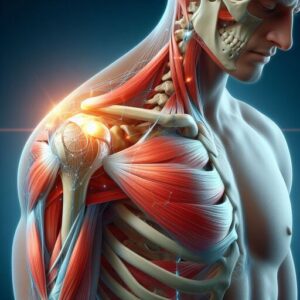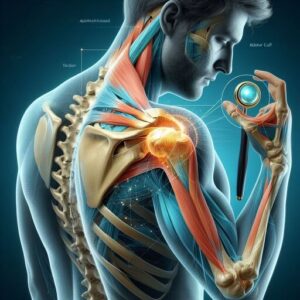Shoulder Impingement Syndrome
Shoulder impingement is a common source of shoulder discomfort and a common symptom of restricted arm movement.
This condition develops when the rotator cuff tendon, responsible for shoulder mobility, significantly rubs against nearby tissues and bones while raising the arm.
Shoulder Anatomy and Impingement Mechanism
Understanding the intricate anatomy of the shoulder joint is essential for fully comprehending shoulder impingement.
The shoulder’s many vital components, which include bones, muscles, tendons, and ligaments, provide a wide range of mobility.
The rotator cuff is a group of four tendons and muscles that stabilise the shoulder joint and provide movement to the arm.
The interplay of these muscles and tendons provides coordination and ease of shoulder movement.
But when you have an impingement in your shoulder, the rotator cuff tendon is open to pressure and friction from all directions, which means your arm will hurt and be uncomfortable whenever you move it.
Symptoms and Look
- Shoulder impingement can cause many symptoms, including mild discomfort and severe pain. Common symptoms include:
- Pain on the top and outside of the shoulder worsens with arm movement, mainly when the arm is raised above the head.
- Pain during the night frequently impairs sleep and overall quality of life.

The affected arm’s weakness or diminished strength makes it difficult to perform daily tasks and functional motions.
Varying degrees and durations of these symptoms are possible. While some people feel pain immediately, others must wait for their symptoms to worsen.
Diagnosis and Medical Evaluation
See a medical professional to determine the source and best course of therapy for persistent shoulder pain or discomfort.
A medical expert, usually a general practitioner (GP) or orthopaedic surgeon, will thoroughly evaluate your shoulder. This process includes a comprehensive physical exam and imaging studies, such as X-rays or an MRI.
The doctor will check your range of motion, strength, and capacity to endure pain during the examination.
This examination will help rule out rotator cuff tears and osteoarthritis as possible causes of shoulder discomfort and detect impingement.
Treatment Alternatives And Management Strategies
Conservative treatment methods, along with, in rare cases, surgical intervention, are utilised to alleviate shoulder impingement.
The severity of the symptoms, the underlying reasons, and the patient’s traits influence the therapy decision.
Conservative Treatments:
If you suffer from shoulder discomfort, one way to modify your activity is to avoid doing things that make it worse, such as lifting heavy objects or repeating the motions above.
Resting the shoulder may require making short-term adjustments to regular activities.
Physical treatment: A planned physical therapy programme focusing on shoulder strengthening, flexibility exercises, and posture correction can help improve shoulder function and pain relief.
An expert physiotherapist can customise the workouts to address individual weaknesses and improve recovery.
Pain relief: Nonsteroidal anti-inflammatory medicines (NSAIDs) or over-the-counter pain relievers can help reduce shoulder discomfort and inflammation.
However, these drugs are typically used as supplementary therapy and should only be used under the supervision of a physician.
Modalities: Ice packs and heat therapy can help reduce shoulder discomfort and inflammation.
Symptomatic relief can be obtained using ice packs for 15 to 20 minutes daily or the suggested heat therapy.
Advanced Treatments:
When other, more conservative treatments have failed to alleviate swelling and pain in the shoulder, injecting the joint with corticosteroids can provide temporary relief.
These injections are usually performed under fluoroscopic or ultrasound guidance to guarantee accuracy and precision.
Two other modern regenerative treatments aiding shoulder repair are platelet-rich plasma (PRP) injections and stem cell therapy.
Alternative methods may help certain patients while research into these medicines’ effectiveness continues.
If the symptoms persist after conservative treatment or if structural damage to the shoulder is discovered, surgical treatments may be necessary.
One surgical option for treating shoulder impingement is arthroscopic decompression, which entails altering or eliminating the structures that contribute to the problem.

Recovery and Rehabilitation
Following surgery or conservative treatment, a systematic rehabilitation programme is required to improve shoulder function and prevent problems from recurring.
Physiotherapy plays a crucial role in the recovery process by systematically enhancing the shoulder joint’s functional capacities, strength, and range of motion.
Prevention Strategies
Although it’s not always possible to prevent shoulder impingement, you can lessen your chances of getting it by following these steps:
The user’s failure to adhere to good ergonomics and posture can lead to unnecessary pressure on the shoulder and surrounding tissues from regular tasks.
Gradually increase activities: To avoid overstressing your shoulder muscles and tendons, it is recommended to ease into more strenuous workouts or exercise programmes.
Cross-training: A varied workout programme is a way to keep your shoulders healthy and free from overuse injuries.
Do shoulder-specific stretching and strengthening exercises regularly to keep your shoulders flexible and strong and reduce the risk of impingement.
A common cause of shoulder pain known as impingement syndrome can negatively impact a person’s ability to go about their daily lives.
Learning about the problem’s origins, symptoms, and treatment options can help one take preventative measures to address shoulder impingement and successfully avoid long-term consequences.
Prompt medical diagnosis, appropriate treatment, and rehabilitation can help many patients with shoulder impingement greatly reduce their symptoms and get back to their typical activities with modest restrictions.
References
- Mastering Shoulder Impingement: Expert Tips with Zlaant!. https://www.zlaant.com/blogs/news/mastering-shoulder-impingement-expert-tips-with-zlaant
- Shoulder Injury After A Motor Vehicle Accident (CTP Claim). https://www.physioparramatta.com.au/shoulder-injury-after-a-motor-vehicle-accident-ctp-claim/
- Shoulder Pain in The Woodlands, TX | Movement Orthopaedic. https://www.movementorthopaedic.com/areas-treated/shoulder/
The post Understanding Shoulder Impingement appeared first on Rehabilitation Therapy Preston.
The Article A Guide To Shoulder Impingement Syndrome appeared first on MCR Therapies.
The Article A Guide To Shoulder Impingement Syndrome Was Found On https://limitsofstrategy.com


Your exploration of shoulder impingement syndrome wonderfully captures the complexity of this often-overlooked condition. It made me reflect on how frequently we take for granted the intricate mechanics of our bodies, particularly in the shoulder region, which is so crucial for our daily activities.
You raise an important point about how we often overlook the complexities of our body’s mechanics, especially in the shoulder region. It’s interesting to consider how daily activities, from lifting groceries to reaching for something on a high shelf, can be impacted by even minor issues with our shoulder function.
You’re so right about the complexities of our body’s mechanics and how easily we can take them for granted. I remember a time when I started experiencing some discomfort in my shoulder after carrying a heavy bag during my commute. It made me acutely aware of just how much we rely on that delicate balance of muscles and joints for what seems like simple tasks.
It’s fascinating how our bodies adapt to everyday activities, isn’t it? That discomfort in your shoulder really illustrates how intricate our mechanics are. Carrying a heavy bag seems trivial until we realize the strain it puts on our muscles and joints. It’s like our body is this finely tuned machine, and even a slight imbalance can lead to discomfort or injury.
I can definitely relate to that experience. It’s fascinating how something we often overlook—like the mechanics of our shoulders—can turn into a reminder of just how crucial they are to our everyday movements. I remember a time when I strained my back simply from doing some yard work. Suddenly, activities I took for granted felt like they required a whole new strategy.
It’s interesting how those moments can shift our perspective on our bodies, isn’t it? I remember spraining my ankle while just walking my dog, and it made me so much more aware of how I move through everyday tasks. Suddenly, I found myself analyzing how I navigate stairs or even just getting out of bed. It’s like our bodies send us these little reminders to slow down and appreciate the mechanics at play.
It really is fascinating how those moments can shift our perspective on our bodies. I’ve had similar experiences that made me pause and reflect on my own habits, like the time I pulled a muscle while trying to reach for something awkwardly. It was a humbling reminder that our bodies are not just vessels; they have their limits and deserve our attention.
You really hit on something important with that reflection. It’s fascinating how an unexpected injury, like your ankle sprain, can turn everyday movements into a kind of puzzle to solve. We take so much for granted in our daily routines—the simple act of getting out of bed or climbing stairs becomes this intricate dance we rarely scrutinize until we’re forced to.
You make such a great point about how those unexpected moments can create a shift in our perspective. It’s fascinating how something as simple as a sprained ankle can spark a deeper awareness of our everyday movements. I can relate to that experience of suddenly analyzing the way we navigate the world. It’s as if those little accidents act as a reset button, shining a light on the intricate mechanics we often take for granted.
It’s interesting how those seemingly minor moments, like yard work, can become profound reminders of how interconnected our bodies are. I had a similar experience a while back when I started doing some home renovations. I was lifting and climbing for what felt like hours, and by the end of the day, I realized just how much I had taken for granted the strength and flexibility of my back and shoulders.
It’s interesting how a little discomfort can really open our eyes to the way our bodies work, isn’t it? That experience with your shoulder is something many of us can relate to. It’s often the little things, like carrying a heavy bag, that make us realize how much we rely on our muscles and joints to get through the day.
It’s interesting how a simple discomfort can awaken us to the complex workings of our bodies, isn’t it? Your shoulder pain is a reminder of how interconnected everything is—from the way we move to how we carry our daily burdens, both literal and metaphorical.
It’s true that discomfort can serve as a catalyst for deeper awareness about how we engage with our bodies. Often, we navigate our daily lives with such a sense of routine that we forget how our movements and habits intertwine with our overall well-being. When something like shoulder pain surfaces, it’s not just an isolated issue; it can feel like a wake-up call, highlighting the various ways we physically and emotionally shoulder our burdens.
You make a great observation about the shoulder’s role in our daily activities and how often we take it for granted. I’ve definitely noticed that minor tweaks or aches can really throw off seemingly simple tasks, like reaching up to grab something from a shelf or even just lifting my arm to stretch. It’s fascinating how we rely on a complex network of muscles and joints to perform these actions without even thinking about it.
It’s so true how those minor tweaks can really disrupt our daily flow. Just think about how many times we reach for something without a second thought, all thanks to our shoulder’s incredible range of motion and strength. It can feel like we’re cruising through life, completely dependent on this network of muscles and joints, and then something as simple as raising an arm can suddenly become a chore.
It’s interesting how easily we take our bodies for granted, isn’t it? Just the other day, I was reaching for something on a top shelf, and it struck me how much I rely on that fluid motion. It’s almost humbling to realize how a little tweak—or an injury—can shift our entire daily routine.
You’ve hit the nail on the head there. It’s pretty wild how much we rely on our shoulders for what seems like the most mundane tasks. When those minor tweaks or aches come up, it’s a real reminder of just how interconnected everything is—muscles, joints, even the tiniest little tendons working together.
It’s so true how we often take our shoulders for granted until something goes awry. I mean, it’s fascinating to think about how many daily activities rely on them—everything from typing on a keyboard to throwing a frisbee. I’ve definitely been there, feeling a twinge in my shoulder after a long day at the computer, and it really makes you pause and appreciate how everything is linked.
It’s so true how easily we overlook our shoulders until something goes wrong. I remember a time when I was on a hiking trip, and all it took was a small strain from adjusting my bag to realize just how much I relied on that range of motion. It’s kind of wild, right? You think you’re well-prepared and then something as simple as lifting your arm becomes an unexpected challenge.
I can totally relate to that moment of realization about how much we take our bodies for granted. It’s fascinating how something as simple as lifting your arm can turn into a big deal when you’re doing something active like hiking. I’ve had a few experiences where I underestimated the toll that physical strain can take. A lot of people focus on their legs and endurance for hiking, but shoulders and back play such a vital role in carrying gear and maintaining balance.
I totally get what you mean—it’s incredible how quickly we realize the importance of our shoulders until they start acting up; I found this article that dives into the causes and effective treatments for shoulder tendonitis, which might be really helpful if you’re dealing with any discomfort.
‘Shoulder Tendonitis Treatment: Causes and Effective Solutions’
https://deepernyc.com/shoulder-tendonitis-treatment-causes-and-effective-solutions/.
It’s interesting how life’s little moments can really highlight our reliance on body mechanics we often take for granted. That strain from adjusting your bag sounds like it could’ve turned into quite the frustration, especially when you’re out in nature and want to keep moving.
It’s interesting how often we take our bodies for granted until something reminds us of their complexity and fragility. That experience you shared on your hiking trip really highlights how interconnected all our muscles and joints are. I remember going for a run once and suddenly felt a twinge in my shoulder when I raised my arm to swipe a branch out of the way. It’s funny how a seemingly minor movement can reveal just how much we depend on our bodies for even the simplest tasks.
You make a great point about not really understanding what our bodies can do until we experience a little hiccup, like a twinge or a twist. It’s fascinating how interconnected everything is; one small movement can send a signal along the muscle chain that reminds us just how complex our anatomy is.
You’re so right about the intricacies of our body’s mechanics, particularly with the shoulder. It’s often a part of our anatomy that doesn’t get the attention it deserves until we experience discomfort. I remember when I started incorporating more weightlifting into my routine, how I had to be mindful of my shoulder positioning—what felt like a minor tweak turned out to be pivotal in preventing injury during lifts.
You’ve hit the nail on the head about shoulder mechanics. It’s fascinating how such a complex joint can often be overlooked until there’s an issue. I had a similar experience when I started doing more functional training—realizing just how much my shoulder positioning affected not just my lifts but also my overall movement.
It’s interesting how we often overlook the body’s mechanics until something goes awry. The shoulder, in particular, is a marvel of mobility and stability, yet so many of us don’t think about its complexity until we experience pain or discomfort. I remember talking to a physical therapist who emphasized the importance of maintaining shoulder strength and flexibility, especially for those of us who spend long hours at desks or in front of screens.
You raise such a good point about how we often take our bodies for granted, especially with something as complex as the shoulder. It really is incredible how much we rely on it for everyday activities, yet tend to ignore it until discomfort kicks in. I can relate to that experience; I’ve spent long hours at a desk, and it’s easy to slip into poor posture or to stay in one position for too long.
You’ve brought up such an important aspect of our daily lives. It’s interesting how we often don’t realize the toll that long hours at a desk can take on our bodies until we start feeling the discomfort. I think most of us can relate to getting so wrapped up in work that we kind of forget to check in with ourselves physically. I’ve definitely fallen into that trap, and it’s shocking how quickly little postural issues can develop into something more significant.
You hit the nail on the head! It’s wild how we can lose track of our bodies while our brains are zooming along at full throttle. I often find myself locked in my chair like a time traveler, suddenly glancing at the clock only to realize I’ve been in “deadline mode” for hours. Who knew that simply sitting down could lead to an impromptu performance of ‘The Twist’ and not the fun kind involving dance, but rather the tragic ‘twist’ of my back and neck?